Naringenin Targets PI3K p85alpha to Suppress PI3K/AKT Signaling Pathway and Ameliorate Disordered MMP-9 Secretion in Cigarette Smoke Extract-Induced Alveolar Macrophages In Vitro
Abstract
1. Introduction
2. Materials and Methods
2.1. Chemicals and Reagents
2.2. Cell Culture and Treatment
2.3. Cell Viability Assay
2.4. Enzyme Linked Immunosorbent Assay (ELISA)
2.5. Proteomics Analysis
2.6. Western Blot Analysis
2.7. Molecular Docking Studies
2.8. Molecular Dynamics (MD) Simulations
2.9. Cellular Thermal Shift Assay (CETSA)
2.10. Determination of Class/PI3K Activity
2.11. Primary Mouse Alveolar Macrophages Preparation and Marker Staining
2.12. Statistical Analysis
3. Results
3.1. Naringenin Inhibited the Secretion of MMP-9 in CSE-Induced MH-S Cells
3.2. Proteomics Analysis of Naringenin Treatment in CSE-Induced MH-S Cells
3.3. Naringenin Decreased CSE-Induced Expressions of the PI3K/AKT Signaling Pathway in MH-S Cells
3.4. Naringenin Inhibited CSE-Induced MMP-9 Expression and Secretion by Downregulation of PI3K Phosphorylation
3.5. Molecular Docking Studies Between Naringenin and PI3K/AKT/MMP-9 Proteins
3.6. MD Simulation Analysis of the Interactions Between Naringenin and PI3K Proteins
3.7. Naringenin Binds to PI3K p85alpha and Inhibits the Enzyme Activity of PI3K
3.8. The Beneficial Effects of Inhibiting MMP-9 Secretion from Alveolar Macrophages Against Elastin and E-Cadherin Damage in Alveolar Epithelial Cells
4. Discussion
5. Conclusions
Author Contributions
Funding
Institutional Review Board Statement
Informed Consent Statement
Data Availability Statement
Acknowledgments
Conflicts of Interest
Abbreviations
| BALF | bronchoalveolar lavage fluid |
| BCA | bicinchoninic acid assay |
| CETSA | cellular thermal shift assay |
| CM | conditioned medium |
| COPD | chronic obstructive pulmonary disease |
| CSE | cigarette smoke extract |
| DMSO | dimethyl sulfoxide |
| ECM | extracellular matrix |
| ELISA | enzyme linked immunosorbent assay |
| FC | fold change |
| FDR | false discovery rate |
| FEL | free energy landscape |
| H-bond | hydrogen bond |
| LC | liquid chromatography |
| MD simulations | molecular dynamics simulations |
| MMPBSA | molecular mechanics Poisson–Boltzmann surface area |
| MMP-9 | matrix metalloproteinase-9 |
| MS | mass spectrometer |
| MTS | 3-(4,5-Dimethylthiazol-2-yl)-5-(3-carboxymethoxyphenyl)-2-(4-sulfophenyl)-2H-tetrazolium |
| NPT | constant-pressure and constant-temperature |
| NVT | canonical ensemble |
| Rg | radius of gyration |
| RMSD | root mean square deviation |
| RMSF | root mean square fluctuation |
| SASA | solvent accessible surface area |
| SD | standard deviation |
References
- Collaborators, G.R.F. Global burden and strength of evidence for 88 risk factors in 204 countries and 811 subnational locations, 1990–2021: A systematic analysis for the Global Burden of Disease Study 2021. Lancet 2024, 403, 2162–2203. [Google Scholar] [CrossRef]
- Geng, X.; Wang, Y.; Li, H.; Chen, D.D.Y. Characterization of cigarette smokeomics by in situ solid-phase microextraction and confined-space direct analysis in real time mass spectrometry. Talanta 2024, 280, 126680. [Google Scholar] [CrossRef] [PubMed]
- Jokipii Krueger, C.C.; Park, S.L.; Patel, Y.; Stram, D.O.; Aldrich, M.; Cai, Q.; Tretyakova, N.Y. Association of Urinary N7-(1-hydroxyl-3-buten-1-yl) Guanine (EB-GII) Adducts and Butadiene-Mercapturic Acids with Lung Cancer Development in Cigarette Smokers. Chem. Res. Toxicol. 2024, 37, 374–384. [Google Scholar] [CrossRef]
- Pinto, E.; Cruz, M.; Ramos, P.; Santos, A.; Almeida, A. Metals transfer from tobacco to cigarette smoke: Evidences in smokers’ lung tissue. J. Hazard. Mater. 2017, 325, 31–35. [Google Scholar] [CrossRef] [PubMed]
- Agache, I.; Ricci-Cabello, I.; Canelo-Aybar, C.; Annesi-Maesano, I.; Cecchi, L.; Biagioni, B.; Chung, K.F.; D’Amato, G.; Damialis, A.; Del Giacco, S.; et al. The impact of exposure to tobacco smoke and e-cigarettes on asthma-related outcomes: Systematic review informing the EAACI guidelines on environmental science for allergic diseases and asthma. Allergy 2024, 79, 2346–2365. [Google Scholar] [CrossRef]
- Dai, Y.; Yang, W.; Song, H.; He, X.; Guan, R.; Wu, Z.; Jiang, X.; Li, M.; Liu, P.; Chen, J. Long-term effects of chronic exposure to electronic cigarette aerosol on the cardiovascular and pulmonary system in mice: A comparative study to cigarette smoke. Environ. Int. 2024, 185, 108521. [Google Scholar] [CrossRef]
- Dai, X.; Gil, G.F.; Reitsma, M.B.; Ahmad, N.S.; Anderson, J.A.; Bisignano, C.; Carr, S.; Feldman, R.; Hay, S.I.; He, J.; et al. Health effects associated with smoking: A Burden of Proof study. Nat. Med. 2022, 28, 2045–2055. [Google Scholar] [CrossRef]
- Ylitörmänen, T.; Tarasenko, Y.N.; Ruokolainen, O.; Hiilamo, H.; Pekka, P.; Ollila, H. Implementation of the Article 13 WHO FCTC measures and changes in cigarette smoking among youth in 42 countries. BMJ Glob. Health 2023, 8, e013255. [Google Scholar] [CrossRef]
- Mildner, A.; Yona, S. Mapping the lung. Science 2019, 363, 1154–1155. [Google Scholar] [CrossRef]
- Hume, P.S.; Gibbings, S.L.; Jakubzick, C.V.; Tuder, R.M.; Curran-Everett, D.; Henson, P.M.; Smith, B.J.; Janssen, W.J. Localization of Macrophages in the Human Lung via Design-based Stereology. Am. J. Respir. Crit. Care Med. 2020, 201, 1209–1217. [Google Scholar] [CrossRef]
- Neupane, A.S.; Willson, M.; Chojnacki, A.K.; Vargas, E.S.C.F.; Morehouse, C.; Carestia, A.; Keller, A.E.; Peiseler, M.; DiGiandomenico, A.; Kelly, M.M.; et al. Patrolling Alveolar Macrophages Conceal Bacteria from the Immune System to Maintain Homeostasis. Cell 2020, 183, 110–125.e111. [Google Scholar] [CrossRef]
- Lugg, S.T.; Scott, A.; Parekh, D.; Naidu, B.; Thickett, D.R. Cigarette smoke exposure and alveolar macrophages: Mechanisms for lung disease. Thorax 2022, 77, 94–101. [Google Scholar] [CrossRef]
- Lam, T.Y.W.; Nguyen, N.; Peh, H.Y.; Shanmugasundaram, M.; Chandna, R.; Tee, J.H.; Ong, C.B.; Hossain, M.Z.; Venugopal, S.; Zhang, T.; et al. ISM1 protects lung homeostasis via cell-surface GRP78-mediated alveolar macrophage apoptosis. Proc. Natl. Acad. Sci. USA 2022, 119, e2019161119. [Google Scholar] [CrossRef]
- Hendrix, A.Y.; Kheradmand, F. The Role of Matrix Metalloproteinases in Development, Repair, and Destruction of the Lungs. Prog. Mol. Biol. Transl. Sci. 2017, 148, 1–29. [Google Scholar] [CrossRef]
- Sutherland, T.E.; Dyer, D.P.; Allen, J.E. The extracellular matrix and the immune system: A mutually dependent relationship. Science 2023, 379, eabp8964. [Google Scholar] [CrossRef]
- Al-Husinat, L.; Azzam, S.; Al Sharie, S.; Al Sharie, A.H.; Battaglini, D.; Robba, C.; Marini, J.J.; Thornton, L.T.; Cruz, F.F.; Silva, P.L.; et al. Effects of mechanical ventilation on the interstitial extracellular matrix in healthy lungs and lungs affected by acute respiratory distress syndrome: A narrative review. Crit. Care 2024, 28, 165. [Google Scholar] [CrossRef]
- Agraval, H.; Kandhari, K.; Yadav, U.C.S. MMPs as potential molecular targets in epithelial-to-mesenchymal transition driven COPD progression. Life Sci. 2024, 352, 122874. [Google Scholar] [CrossRef]
- Cabral-Pacheco, G.A.; Garza-Veloz, I.; Castruita-De la Rosa, C.; Ramirez-Acuña, J.M.; Perez-Romero, B.A.; Guerrero-Rodriguez, J.F.; Martinez-Avila, N.; Martinez-Fierro, M.L. The Roles of Matrix Metalloproteinases and Their Inhibitors in Human Diseases. Int. J. Mol. Sci. 2020, 21, 9739. [Google Scholar] [CrossRef]
- Espindola, M.S.; Habiel, D.M.; Coelho, A.L.; Stripp, B.; Parks, W.C.; Oldham, J.; Martinez, F.J.; Noth, I.; Lopez, D.; Mikels-Vigdal, A.; et al. Differential Responses to Targeting Matrix Metalloproteinase 9 in Idiopathic Pulmonary Fibrosis. Am. J. Respir. Crit. Care Med. 2021, 203, 458–470. [Google Scholar] [CrossRef] [PubMed]
- Blázquez-Prieto, J.; López-Alonso, I.; Amado-Rodríguez, L.; Huidobro, C.; González-López, A.; Kuebler, W.M.; Albaiceta, G.M. Impaired lung repair during neutropenia can be reverted by matrix metalloproteinase-9. Thorax 2018, 73, 321–330. [Google Scholar] [CrossRef]
- Atkinson, J.J.; Lutey, B.A.; Suzuki, Y.; Toennies, H.M.; Kelley, D.G.; Kobayashi, D.K.; Ijem, W.G.; Deslee, G.; Moore, C.H.; Jacobs, M.E.; et al. The role of matrix metalloproteinase-9 in cigarette smoke-induced emphysema. Am. J. Respir. Crit. Care Med. 2011, 183, 876–884. [Google Scholar] [CrossRef] [PubMed]
- Foronjy, R.; Nkyimbeng, T.; Wallace, A.; Thankachen, J.; Okada, Y.; Lemaitre, V.; D’Armiento, J. Transgenic expression of matrix metalloproteinase-9 causes adult-onset emphysema in mice associated with the loss of alveolar elastin. Am. J. Physiol. Lung Cell. Mol. Physiol. 2008, 294, L1149–L1157. [Google Scholar] [CrossRef]
- Staitieh, B.S.; Malik, S.; Auld, S.C.; Wigger, G.W.; Fan, X.; Roth, A.T.; Chatterjee, T.; Arora, I.; Raju, S.V.; Heath, S.; et al. HIV Increases the Risk of Cigarette Smoke-Induced Emphysema Through MMP-9. J. Acquir. Immune Defic. Syndr. 2023, 92, 263–270. [Google Scholar] [CrossRef]
- Liu, Z.; Niu, X.; Wang, J. Naringenin as a natural immunomodulator against T cell-mediated autoimmune diseases: Literature review and network-based pharmacology study. Crit. Rev. Food Sci. Nutr. 2023, 63, 11026–11043. [Google Scholar] [CrossRef] [PubMed]
- Uçar, K.; Göktaş, Z. Biological activities of naringenin: A narrative review based on in vitro and in vivo studies. Nutr. Res. 2023, 119, 43–55. [Google Scholar] [CrossRef]
- Jia, Y.; Zhang, L.; Liu, Z.; Mao, C.; Ma, Z.; Li, W.; Yu, F.; Wang, Y.; Huang, Y.; Zhang, W.; et al. Targeting macrophage TFEB-14-3-3 epsilon Interface by naringenin inhibits abdominal aortic aneurysm. Cell Discov. 2022, 8, 21. [Google Scholar] [CrossRef]
- Guan, M.; Shi, R.; Zheng, Y.; Zeng, X.; Fan, W.; Wang, Y.; Su, W. Characterization, in Vitro and in Vivo Evaluation of Naringenin-Hydroxypropyl-ß-Cyclodextrin Inclusion for Pulmonary Delivery. Molecules 2020, 25, 554. [Google Scholar] [CrossRef]
- Cai, J.; Wen, H.; Zhou, H.; Zhang, D.; Lan, D.; Liu, S.; Li, C.; Dai, X.; Song, T.; Wang, X.; et al. Naringenin: A flavanone with anti-inflammatory and anti-infective properties. Biomed. Pharmacother. 2023, 164, 114990. [Google Scholar] [CrossRef]
- Zhou, L.; Gu, W.; Kui, F.; Gao, F.; Niu, Y.; Li, W.; Zhang, Y.; Guo, L.; Wang, J.; Guo, Z.; et al. The mechanism and candidate compounds of aged citrus peel (chenpi) preventing chronic obstructive pulmonary disease and its progression to lung cancer. Food Nutr. Res. 2021, 65, 7526. [Google Scholar] [CrossRef]
- Singh, P.; Bansal, S.; Kuhad, A.; Kumar, A.; Chopra, K. Naringenin ameliorates diabetic neuropathic pain by modulation of oxidative-nitrosative stress, cytokines and MMP-9 levels. Food Funct. 2020, 11, 4548–4560. [Google Scholar] [CrossRef]
- Fakhri, S.; Sabouri, S.; Kiani, A.; Farzaei, M.H.; Rashidi, K.; Mohammadi-Farani, A.; Mohammadi-Noori, E.; Abbaszadeh, F. Intrathecal administration of naringenin improves motor dysfunction and neuropathic pain following compression spinal cord injury in rats: Relevance to its antioxidant and anti-inflammatory activities. Korean J. Pain 2022, 35, 291–302. [Google Scholar] [CrossRef]
- Chang, H.L.; Chang, Y.M.; Lai, S.C.; Chen, K.M.; Wang, K.C.; Chiu, T.T.; Chang, F.H.; Hsu, L.S. Naringenin inhibits migration of lung cancer cells via the inhibition of matrix metalloproteinases-2 and -9. Exp. Ther. Med. 2017, 13, 739–744. [Google Scholar] [CrossRef]
- Fan, W.; Xu, Z.; Zhang, J.; Guan, M.; Zheng, Y.; Wang, Y.; Wu, H.; Su, W.; Li, P. Naringenin regulates cigarette smoke extract-induced extracellular vesicles from alveolar macrophage to attenuate the mouse lung epithelial ferroptosis through activating EV miR-23a-3p/ACSL4 axis. Phytomed. Int. J. Phytother. Phytopharm. 2024, 124, 155256. [Google Scholar] [CrossRef] [PubMed]
- Zhang, J.; Fan, W.; Wu, H.; Yao, Y.; Jin, L.; Chen, R.; Xu, Z.; Su, W.; Wang, Y.; Li, P. Naringenin attenuated airway cilia structural and functional injury induced by cigarette smoke extract via IL-17 and cAMP pathways. Phytomed. Int. J. Phytother. Phytopharm. 2024, 126, 155053. [Google Scholar] [CrossRef]
- Demichev, V.; Messner, C.B.; Vernardis, S.I.; Lilley, K.S.; Ralser, M. DIA-NN: Neural networks and interference correction enable deep proteome coverage in high throughput. Nat. Methods 2020, 17, 41–44. [Google Scholar] [CrossRef] [PubMed]
- Che, X.H.; Liu, Q.L.; Zhang, L. An accurate and universal protein-small molecule batch docking solution using Autodock Vina. Results Eng. 2023, 19, 101335. [Google Scholar] [CrossRef]
- Hussain, S.; Iqbal, A.; Hamid, S.; Putra, P.P.; Ashraf, M. Identifying alkaline phosphatase inhibitory potential of cyclooxygenase-2 inhibitors: Insights from molecular docking, MD simulations, molecular expression analysis in MCF-7 breast cancer cell line and in vitro investigations. Int. J. Biol. Macromol. 2024, 277, 132721. [Google Scholar] [CrossRef]
- Tu, Y.; Tan, L.; Tao, H.; Li, Y.; Liu, H. CETSA and thermal proteome profiling strategies for target identification and drug discovery of natural products. Phytomed. Int. J. Phytother. Phytopharm. 2023, 116, 154862. [Google Scholar] [CrossRef]
- Busch, C.J.; Favret, J.; Geirsdóttir, L.; Molawi, K.; Sieweke, M.H. Isolation and Long-term Cultivation of Mouse Alveolar Macrophages. Bio-Protoc. 2019, 9, e3302. [Google Scholar] [CrossRef] [PubMed]
- Soares, J.R.P.; Dos Santos, C.C.; de Oliveira, L.M.G.; Rocha Neto, H.; Victor, M.M.; França, E.L.; Costa, M.F.D.; Costa, S.L.; de Oliveira, J.V.R. Synthesis of Naringenin and Senecioic Acid Ester Derivatives and Biological Evaluation of the Astrocyte Antioxidant Mechanism and Reactivity After Inflammatory Stimulus. Int. J. Mol. Sci. 2025, 26, 2215. [Google Scholar] [CrossRef]
- Zhan, K.; Liu, R.; Tong, H.; Gao, S.; Yang, G.; Hossain, A.; Li, T.; He, W. Fetuin B overexpression suppresses proliferation, migration, and invasion in prostate cancer by inhibiting the PI3K/AKT signaling pathway. Biomed. Pharmacother. Biomed. Pharmacother. 2020, 131, 110689. [Google Scholar] [CrossRef] [PubMed]
- Sevilla-Montero, J.; Labrousse-Arias, D.; Fernández-Pérez, C.; Fernández-Blanco, L.; Barreira, B.; Mondéjar-Parreño, G.; Alfaro-Arnedo, E.; López, I.P.; Pérez-Rial, S.; Peces-Barba, G.; et al. Cigarette Smoke Directly Promotes Pulmonary Arterial Remodeling and Kv7.4 Channel Dysfunction. Am. J. Respir. Crit. Care Med. 2021, 203, 1290–1305. [Google Scholar] [CrossRef]
- Zhao, X.; Chen, J.; Sun, H.; Zhang, Y.; Zou, D. New insights into fibrosis from the ECM degradation perspective: The macrophage-MMP-ECM interaction. Cell Biosci. 2022, 12, 117. [Google Scholar] [CrossRef]
- Kim, J.W.; Kim, J.H.; Jeong, J.S.; Kim, C.Y.; Chung, E.H.; Kim, S.H.; Hong, E.J.; Kwon, H.J.; Ko, J.W.; Kim, T.W. Green tea extract suppresses airway inflammation via oxidative stress-driven MAPKs/MMP-9 signaling in asthmatic mice and human airway epithelial cells. Front. Immunol. 2024, 15, 1362404. [Google Scholar] [CrossRef]
- Jiang, J.; Wang, M.; Shen, W.; Wu, J.; Ma, Q.; Wang, Z.; Chen, Z.; Bian, T.; Ji, N.; Huang, M.; et al. CD146 deficiency aggravates chronic obstructive pulmonary disease via the increased production of S100A9 and MMP-9 in macrophages. Int. Immunopharmacol. 2024, 127, 111410. [Google Scholar] [CrossRef]
- Lo, C.Y.; Huang, H.Y.; He, J.R.; Huang, T.T.; Heh, C.C.; Sheng, T.F.; Chung, K.F.; Kuo, H.P.; Wang, C.H. Increased matrix metalloproteinase-9 to tissue inhibitor of metalloproteinase-1 ratio in smokers with airway hyperresponsiveness and accelerated lung function decline. Int. J. Chronic Obstr. Pulm. Dis. 2018, 13, 1135–1144. [Google Scholar] [CrossRef]
- Braber, S.; Koelink, P.J.; Henricks, P.A.; Jackson, P.L.; Nijkamp, F.P.; Garssen, J.; Kraneveld, A.D.; Blalock, J.E.; Folkerts, G. Cigarette smoke-induced lung emphysema in mice is associated with prolyl endopeptidase, an enzyme involved in collagen breakdown. Am. J. Physiol. Lung Cell. Mol. Physiol. 2011, 300, L255–L265. [Google Scholar] [CrossRef]
- Zhou, L.; Le, Y.; Tian, J.; Yang, X.; Jin, R.; Gai, X.; Sun, Y. Cigarette smoke-induced RANKL expression enhances MMP-9 production by alveolar macrophages. Int. J. Chronic Obstr. Pulm. Dis. 2019, 14, 81–91. [Google Scholar] [CrossRef]
- Le, Y.; Cao, W.; Zhou, L.; Fan, X.; Liu, Q.; Liu, F.; Gai, X.; Chang, C.; Xiong, J.; Rao, Y.; et al. Infection of Mycobacterium tuberculosis Promotes Both M1/M2 Polarization and MMP Production in Cigarette Smoke-Exposed Macrophages. Front. Immunol. 2020, 11, 1902. [Google Scholar] [CrossRef] [PubMed]
- Wang, L.; Li, S.; Luo, H.; Lu, Q.; Yu, S. PCSK9 promotes the progression and metastasis of colon cancer cells through regulation of EMT and PI3K/AKT signaling in tumor cells and phenotypic polarization of macrophages. J. Exp. Clin. Cancer Res. CR 2022, 41, 303. [Google Scholar] [CrossRef]
- Gu, H.; Wang, C.; Li, J.; Yang, Y.; Sun, W.; Jiang, C.; Li, Y.; Ni, M.; Liu, W.T.; Cheng, Z.; et al. High mobility group box-1-toll-like receptor 4-phosphatidylinositol 3-kinase/protein kinase B-mediated generation of matrix metalloproteinase-9 in the dorsal root ganglion promotes chemotherapy-induced peripheral neuropathy. Int. J. Cancer 2020, 146, 2810–2821. [Google Scholar] [CrossRef]
- Han, N.R.; Park, H.J.; Ko, S.G.; Moon, P.D. Naringenin, a Food Bioactive Compound, Reduces Oncostatin M Through Blockade of PI3K/Akt/NF-κB Signal Pathway in Neutrophil-like Differentiated HL-60 Cells. Foods 2025, 14, 102. [Google Scholar] [CrossRef]
- Lu, Y.; Deng, M.; Yin, Y.; Hou, G.; Zhou, X. Global Trends in Research Regarding Macrophages Associated with Chronic Obstructive Pulmonary Disease: A Bibliometric Analysis from 2011 to 2022. Int. J. Chronic Obstr. Pulm. Dis. 2023, 18, 2163–2177. [Google Scholar] [CrossRef]
- McCarty, J.H. MMP9 Clears the Way for Metastatic Cell Penetration Across the Blood-Brain Barrier. Cancer Res. 2023, 83, 1167–1169. [Google Scholar] [CrossRef]
- Ghosh, B.; Loube, J.; Thapa, S.; Ryan, H.; Capodanno, E.; Chen, D.; Swaby, C.; Chen, S.; Mahmud, S.; Girgis, M.; et al. Loss of E-cadherin is causal to pathologic changes in chronic lung disease. Commun. Biol. 2022, 5, 1149. [Google Scholar] [CrossRef]
- Booth, S.; Hsieh, A.; Mostaco-Guidolin, L.; Koo, H.K.; Wu, K.; Aminazadeh, F.; Yang, C.X.; Quail, D.; Wei, Y.; Cooper, J.D.; et al. A Single-Cell Atlas of Small Airway Disease in Chronic Obstructive Pulmonary Disease: A Cross-Sectional Study. Am. J. Respir. Crit. Care Med. 2023, 208, 472–486. [Google Scholar] [CrossRef]
- Chin, L.H.; Hon, C.M.; Chellappan, D.K.; Chellian, J.; Madheswaran, T.; Zeeshan, F.; Awasthi, R.; Aljabali, A.A.; Tambuwala, M.M.; Dureja, H.; et al. Molecular mechanisms of action of naringenin in chronic airway diseases. Eur. J. Pharmacol. 2020, 879, 173139. [Google Scholar] [CrossRef]

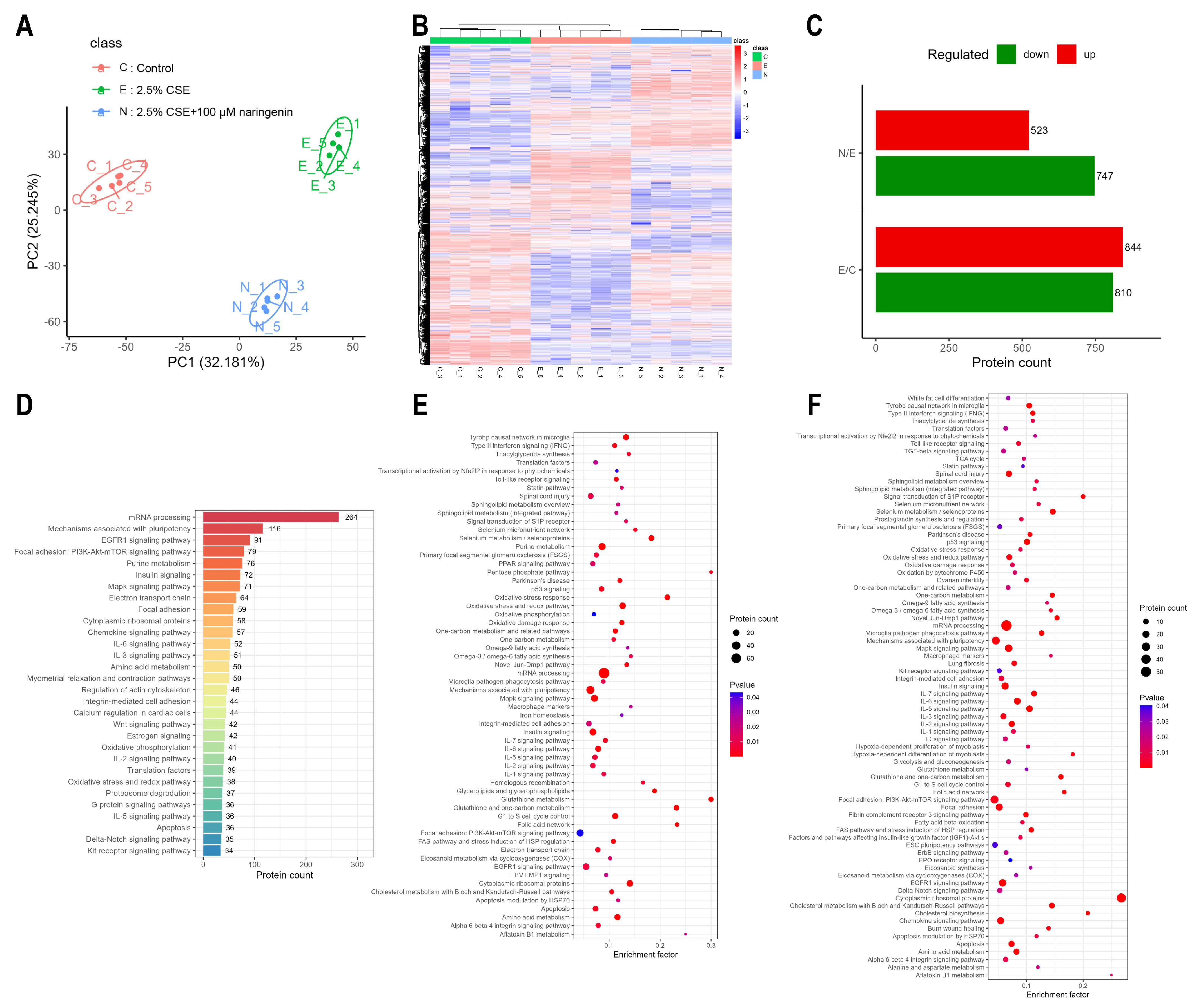
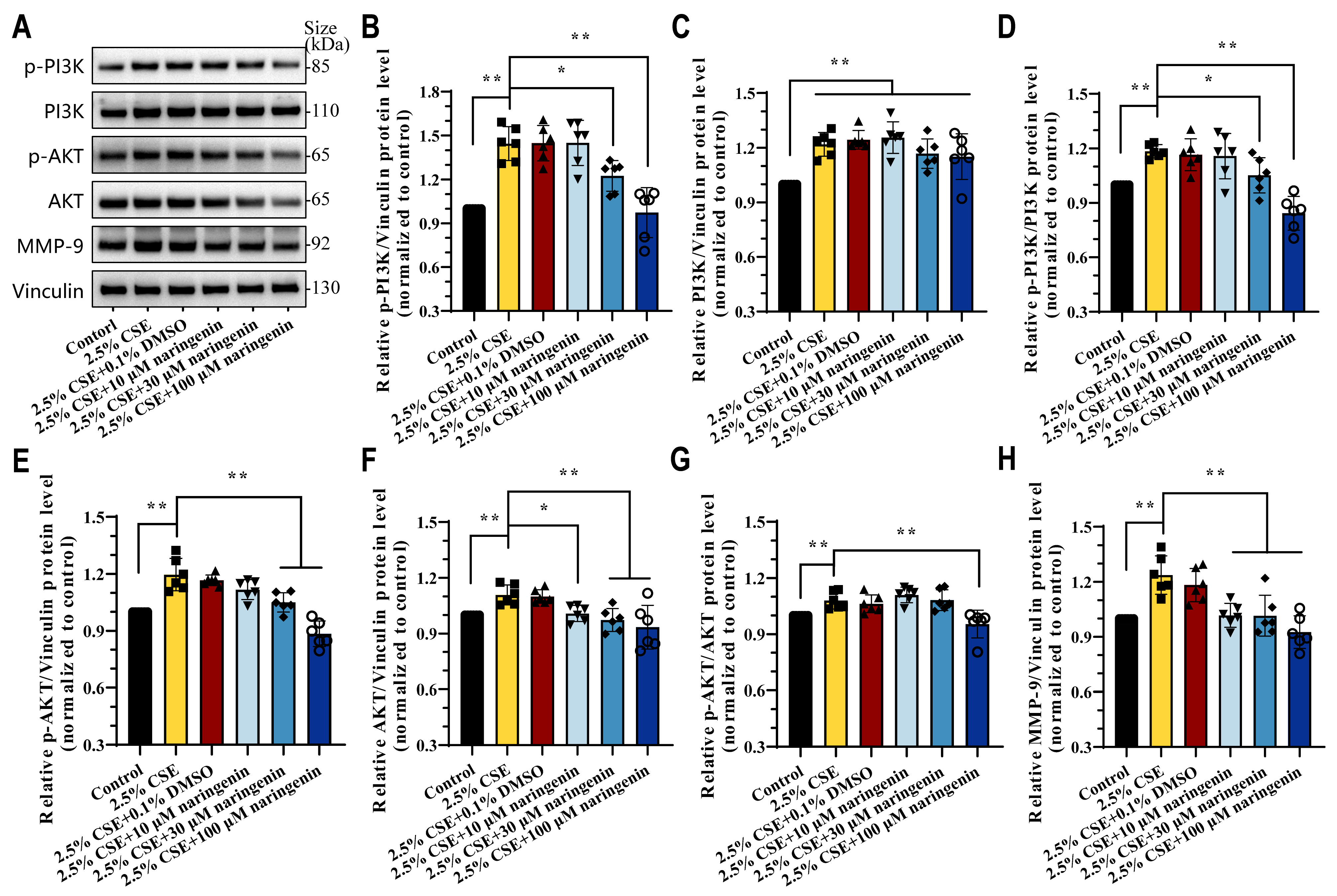
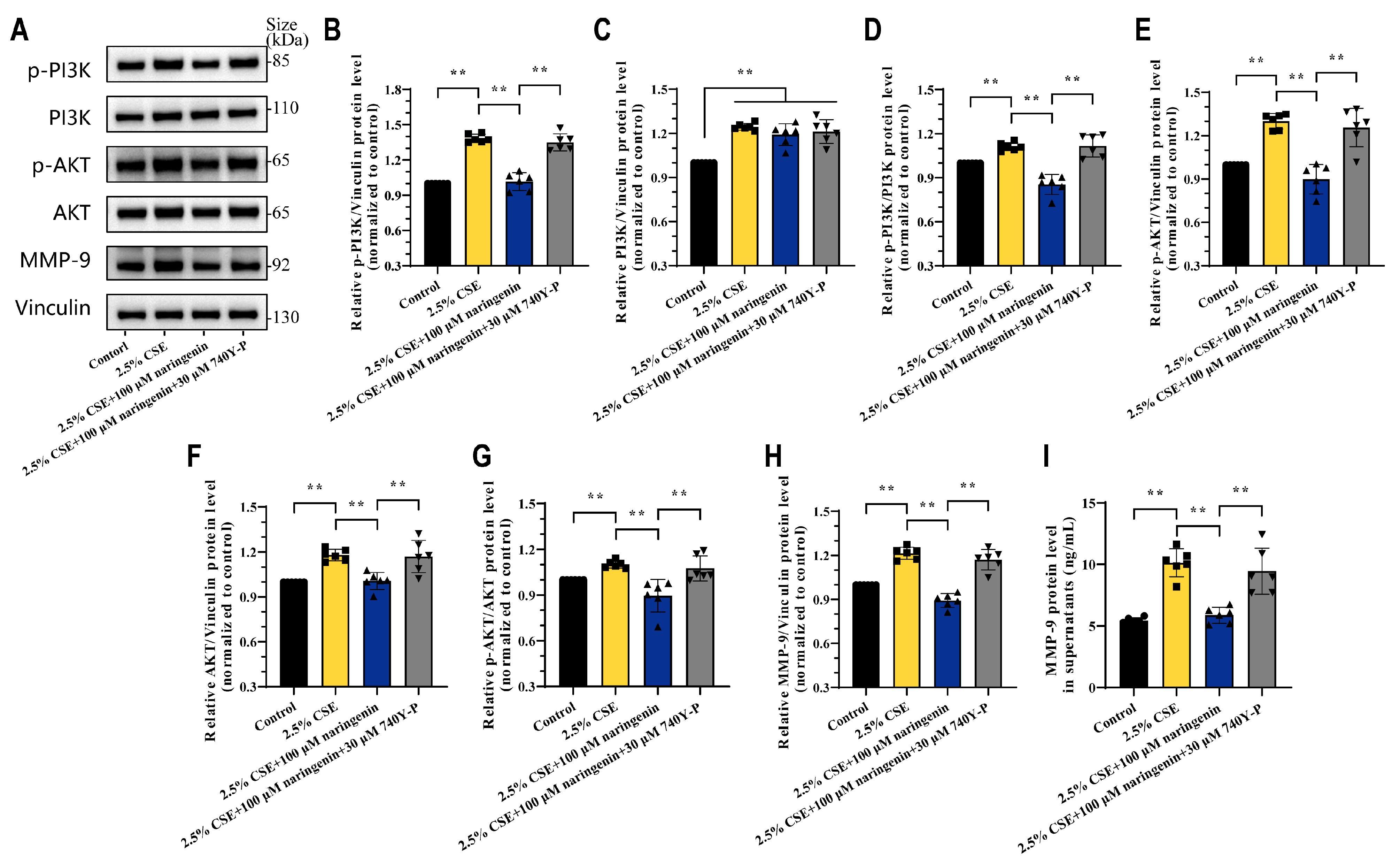
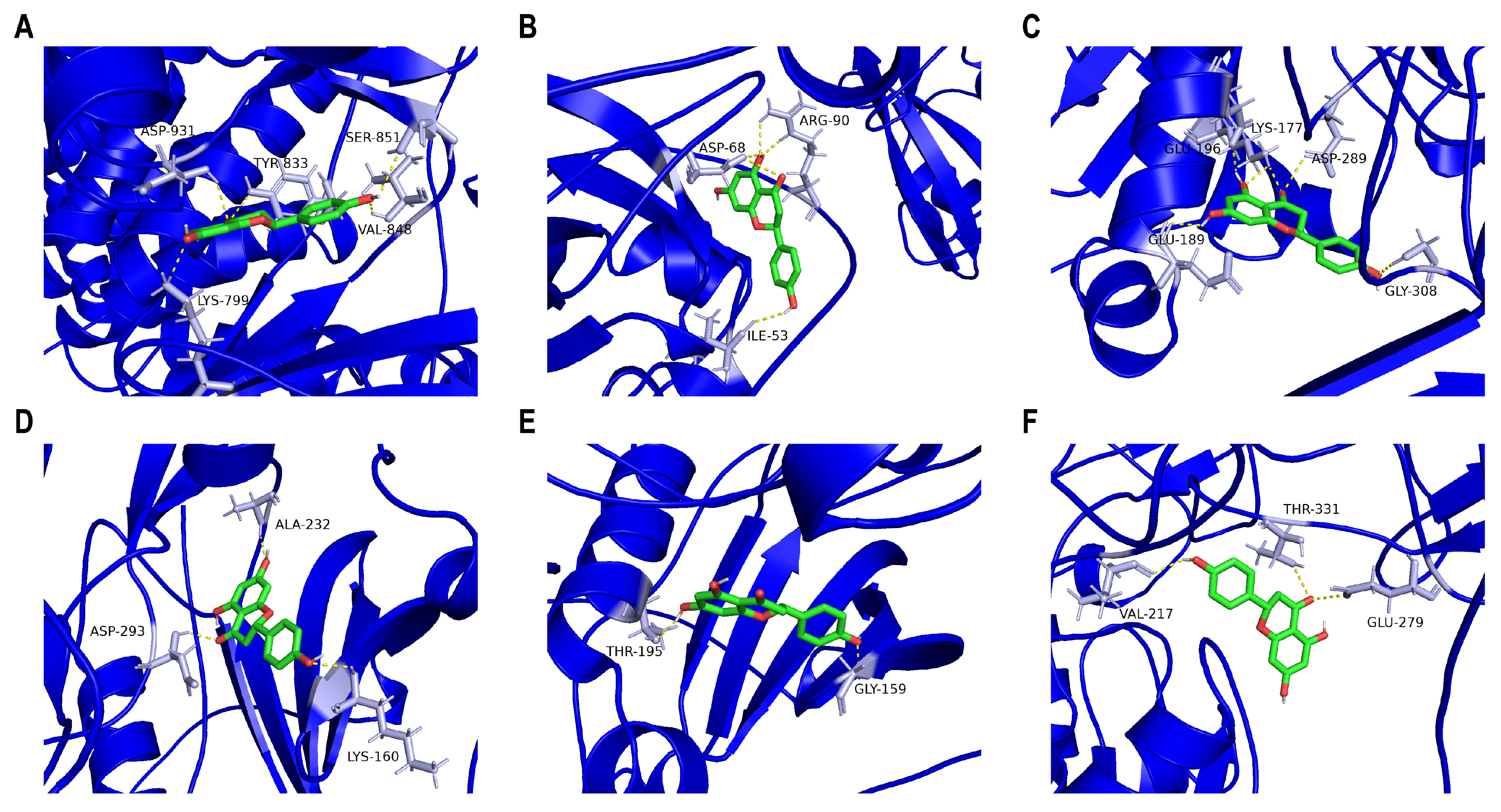
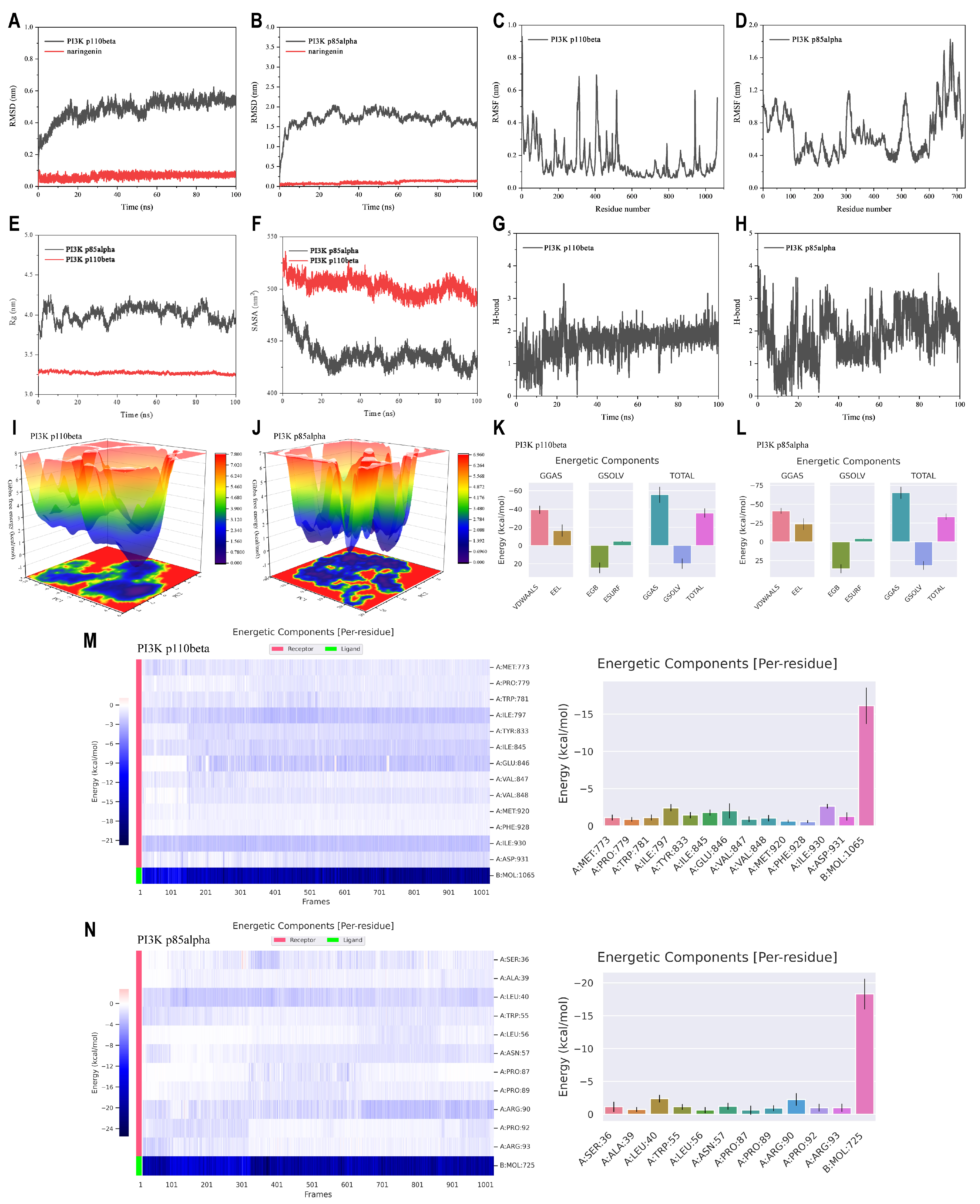



Disclaimer/Publisher’s Note: The statements, opinions and data contained in all publications are solely those of the individual author(s) and contributor(s) and not of MDPI and/or the editor(s). MDPI and/or the editor(s) disclaim responsibility for any injury to people or property resulting from any ideas, methods, instructions or products referred to in the content. |
© 2025 by the authors. Licensee MDPI, Basel, Switzerland. This article is an open access article distributed under the terms and conditions of the Creative Commons Attribution (CC BY) license (https://creativecommons.org/licenses/by/4.0/).
Share and Cite
Fan, W.; Xu, Z.; Zhong, M.; Wu, X.; Chen, P.; Chen, Z.; Su, W.; Wu, H.; Li, P. Naringenin Targets PI3K p85alpha to Suppress PI3K/AKT Signaling Pathway and Ameliorate Disordered MMP-9 Secretion in Cigarette Smoke Extract-Induced Alveolar Macrophages In Vitro. Cells 2025, 14, 678. https://doi.org/10.3390/cells14100678
Fan W, Xu Z, Zhong M, Wu X, Chen P, Chen Z, Su W, Wu H, Li P. Naringenin Targets PI3K p85alpha to Suppress PI3K/AKT Signaling Pathway and Ameliorate Disordered MMP-9 Secretion in Cigarette Smoke Extract-Induced Alveolar Macrophages In Vitro. Cells. 2025; 14(10):678. https://doi.org/10.3390/cells14100678
Chicago/Turabian StyleFan, Weiyang, Ziyan Xu, Mengli Zhong, Xiao Wu, Pan Chen, Zhen Chen, Weiwei Su, Hao Wu, and Peibo Li. 2025. "Naringenin Targets PI3K p85alpha to Suppress PI3K/AKT Signaling Pathway and Ameliorate Disordered MMP-9 Secretion in Cigarette Smoke Extract-Induced Alveolar Macrophages In Vitro" Cells 14, no. 10: 678. https://doi.org/10.3390/cells14100678
APA StyleFan, W., Xu, Z., Zhong, M., Wu, X., Chen, P., Chen, Z., Su, W., Wu, H., & Li, P. (2025). Naringenin Targets PI3K p85alpha to Suppress PI3K/AKT Signaling Pathway and Ameliorate Disordered MMP-9 Secretion in Cigarette Smoke Extract-Induced Alveolar Macrophages In Vitro. Cells, 14(10), 678. https://doi.org/10.3390/cells14100678





